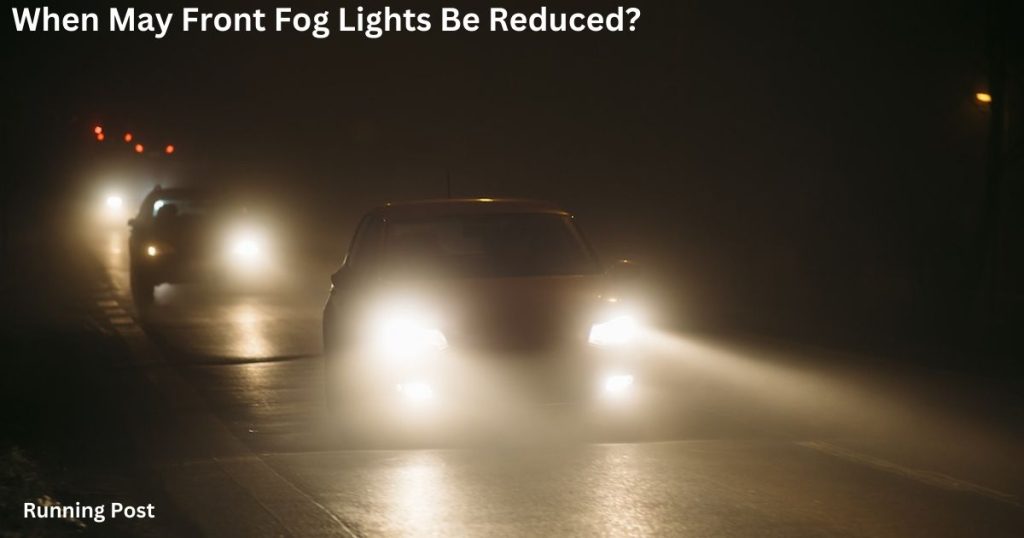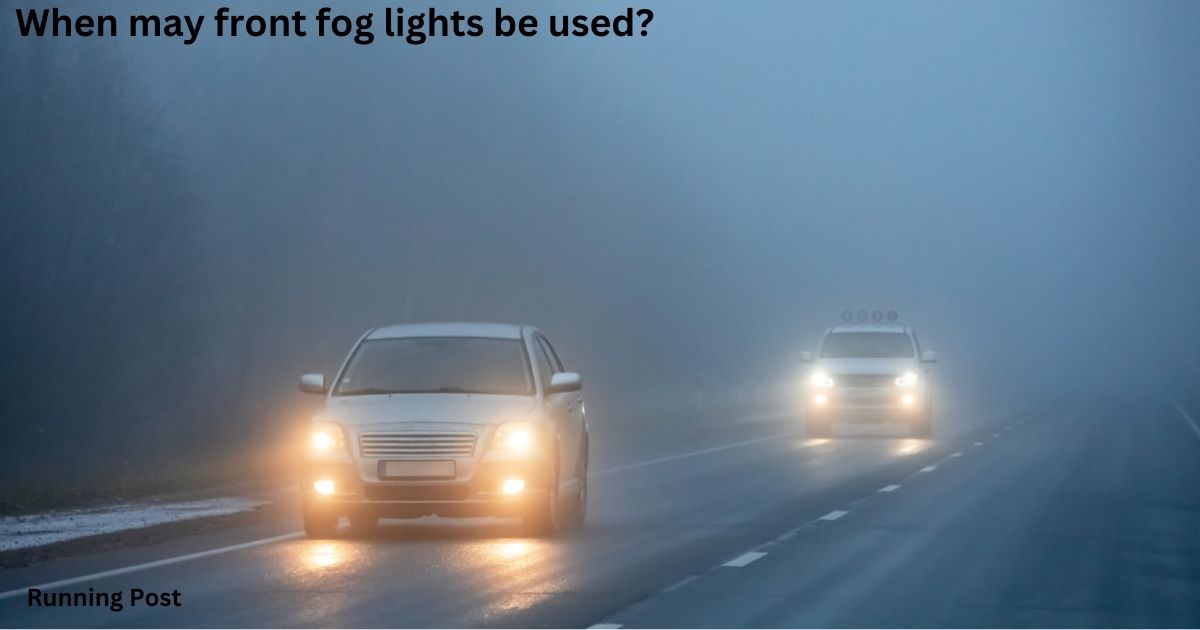| A: When they aren’t as bright as the headlights | B: When visibility is seriously reduced | C: When they’re fitted above the bumper | D: When an audible warning device is used |
Understand The When may front fog lights be used
Introduction
What Are Front Fog Lights?
Front fog lights are specialized automotive lights designed to illuminate the road directly in front of a vehicle during low-visibility conditions. Unlike standard headlights, fog lights are positioned lower on the vehicle and have a wide, flat beam. This design helps reduce the amount of light that is reflected off fog, rain, or snow, improving visibility and reducing glare for the driver. The low position also ensures that the light is directed just above the road surface, enhancing the visibility of road markings and obstacles. Fog lights are often used in conjunction with standard headlights to provide additional illumination when conditions are particularly challenging.
Importance of Understanding Fog Light Usage
Understanding when and how to use front fog lights is crucial for safe driving. Improper use can not only reduce your visibility but also create hazards for other drivers. For instance, using fog lights in clear conditions can cause glare for oncoming traffic, potentially leading to accidents. On the other hand, knowing when to activate these lights can significantly improve your ability to navigate through dense fog, heavy rain, or snowy conditions. Proper usage ensures that you maximize visibility while minimizing the risk of causing discomfort or danger to other road users.
When May Fog Lights Be Used?
Visibility Considerations
Fog lights should be used when visibility is seriously reduced due to adverse weather conditions. These lights are specifically designed to cut through fog, heavy rain, and snow, providing a clearer view of the road ahead. The wide, low beam of fog lights reduces the amount of light that is reflected back by water droplets or snowflakes, which helps to illuminate the road surface more effectively. This improved visibility allows drivers to see road markings, obstacles, and other vehicles more clearly, which is essential for safe driving in challenging conditions.
Foggy Conditions
In dense fog, visibility can be drastically reduced, making it difficult to see beyond a few meters. In such conditions, front fog lights are particularly useful. They help illuminate the road surface and enhance the visibility of road signs and markings. Fog lights are designed to spread light in a wide pattern, which reduces the amount of light that is reflected back by the fog, allowing drivers to see more clearly. It’s important to use fog lights correctly to avoid blinding other drivers and to ensure that they are turned off when visibility improves.
Heavy Rain
Heavy rain can also severely impact visibility, as water droplets scatter light and create glare. Front fog lights are beneficial in such conditions because they provide additional illumination close to the road surface, helping to cut through the glare and improve overall visibility. By using fog lights during heavy rain, drivers can see road markings and potential hazards more clearly. However, it’s important to ensure that fog lights are not used when conditions do not warrant their use, as this can create unnecessary glare for other drivers.
Snow and Ice
Snow and ice can reduce visibility and create hazardous driving conditions. Front fog lights can help improve visibility by illuminating the road surface and reducing glare caused by snow and ice. The low beam pattern of fog lights helps to see through the snow and ice on the road, making it easier to spot potential hazards. Additionally, using fog lights in snowy conditions can help other drivers see your vehicle more clearly, improving overall road safety.
When May Front Fog Lights Be Reduced?

Legal Regulations and Guidelines
Different regions have specific regulations regarding the use of front fog lights. It’s important to be aware of local traffic laws to ensure compliance. In many areas, fog lights should only be used in conditions where visibility is seriously impaired. Using fog lights in clear conditions can result in fines or penalties. Additionally, some regions have specific guidelines on when fog lights should be turned off, such as when approaching oncoming traffic or when driving behind another vehicle.
Local Traffic Laws
Local traffic laws often dictate when and how fog lights can be used. These laws are designed to prevent excessive glare and ensure that fog lights are used only when necessary. In many places, fog lights are required to be turned off when visibility improves or when they are no longer needed. Understanding and adhering to these laws helps ensure that you are using fog lights appropriately and not creating hazards for other drivers.
Manufacturer Recommendations
Vehicle manufacturers provide guidelines on the proper use of fog lights. These recommendations typically include information on when fog lights should be used and when they should be turned off. Following manufacturer recommendations helps ensure that fog lights are used effectively and safely. It’s also important to regularly check and maintain fog lights to ensure they are functioning correctly.
Situations Where Reduction is Necessary
Improving Visibility Without Glare
Reducing the use of front fog lights can help improve visibility without causing glare for other drivers. When driving conditions improve or when approaching oncoming traffic, it is important to turn off fog lights to prevent creating excessive glare. This consideration helps maintain a safe driving environment for everyone on the road.
Changing Weather Conditions
As weather conditions change, the need for front fog lights may vary. For example, if fog lifts or rain decreases, fog lights should be turned off to avoid unnecessary glare. Adjusting the use of fog lights based on changing weather conditions ensures that they are used only when necessary, enhancing overall road safety.
In Which of These Situations Should You Use Front Fog Lights?
Driving in Dense Fog
In dense fog, front fog lights are essential for improving visibility. They cut through the fog and help illuminate the road surface, making it easier to navigate safely. Fog lights should be used when visibility is severely reduced due to fog to ensure that you can see and be seen by other drivers.
How Fog Lights Improve Safety
Fog lights improve safety by providing additional illumination close to the road surface. This helps drivers see road markings, obstacles, and other vehicles more clearly, reducing the risk of accidents. Proper use of fog lights enhances overall driving safety in low-visibility conditions.
Navigating Heavy Rain
During heavy rain, fog lights help reduce glare and improve visibility. They provide additional light close to the road surface, which helps drivers see through the water spray created by other vehicles and spot potential hazards more easily. Using fog lights in heavy rain enhances driving safety by improving visibility.
Reducing Water Spray and Glare
Fog lights help reduce water spray and glare caused by heavy rain. The wide beam of fog lights illuminates the road surface without causing excessive glare, making it easier to see and drive safely. Proper use of fog lights helps manage water spray and glare, improving overall visibility.
Handling Snow and Ice
In snowy or icy conditions, front fog lights help improve visibility by cutting through the snow and ice on the road. They provide additional light close to the road surface, helping drivers spot hazards and navigate safely. Using fog lights in snow and ice conditions enhances road safety by improving visibility.
You Also Like It:
Why is it bad technique to coast when you’re driving downhill?
When do windscreen pillars cause a serious obstruction to your view?
What’s the legal minimum depth of tread for car tyres?
When Should a Driver Use Their Fog Lights?
Best Practices for Fog Light Usage
When to Turn Them On
Fog lights should be turned on when visibility is seriously reduced due to fog, heavy rain, or snow. They are designed to improve visibility in these conditions and should be used only when necessary. It’s important to ensure that fog lights are used appropriately to avoid creating glare for other drivers.
When to Turn Them Off
Fog lights should be turned off when visibility improves or when driving conditions no longer warrant their use. This helps prevent excessive glare and ensures that fog lights are used only when necessary. Regularly checking and adjusting fog light usage based on driving conditions helps maintain road safety.
Common Mistakes to Avoid
Using Fog Lights in Clear Conditions
Using fog lights in clear conditions is a common mistake that can create glare for other drivers and reduce overall road safety. Fog lights should only be used when visibility is significantly reduced due to adverse weather conditions. Ensuring that fog lights are turned off when not needed helps avoid creating hazards for other drivers.
Improper Use and Legal Issues
Improper use of fog lights, such as using them in clear conditions or failing to turn them off when necessary, can lead to legal issues and fines. Adhering to local traffic laws and manufacturer recommendations helps ensure that fog lights are used appropriately and legally. Regularly checking fog lights and understanding their proper use can help avoid legal problems and maintain safe driving practices.
Conclusion About When may front fog lights be used?
Summary of Key Points
Front fog lights are a valuable tool for improving visibility in low-visibility conditions such as fog, heavy rain, and snow. Understanding when and how to use fog lights is crucial for safe driving. They should be used only when visibility is seriously reduced and turned off when conditions improve. Adhering to local traffic laws and manufacturer recommendations helps ensure that fog lights are used appropriately and legally.
Safe Driving Tips for Foggy Conditions
When driving in foggy conditions, it’s important to use fog lights correctly to enhance visibility and safety. Always ensure that fog lights are turned off when not needed to avoid creating glare for other drivers. Additionally, maintaining a safe speed and following distance is essential for navigating safely in adverse weather conditions. By using fog lights appropriately and practicing safe driving habits, you can improve your driving experience and contribute to road safety.
You Also Like It:
When may you drive over a pavement?
What’s the national speed limit for a car on a single carriageway?
By how much can stopping distances increase in icy conditions?
Releated Posts
MAB Instructor Certification: Your Gateway to Professional Crisis Management Leadership
In today’s fast-evolving professional environments—especially in healthcare, mental health, education, and corrections—conflict and aggression can arise without warning.…
Freewayget.com: Your Ultimate Platform for Deals, Discounts, and Digital Products
Introduction to Freewayget.com In today’s fast-paced digital world, finding reliable platforms that offer authentic discounts, deals, and digital…
Affordable & Fast Embroidery Digitizing Services in Your Area
Embroidery digitizing services provide corporations, designers, and people with brilliant embroidery-equipped designs by means of changing art work…
Introduction to hdhub4u nit
In this article, we will delve into the details of hdhub4u nit, exploring its features, benefits, and why…

















